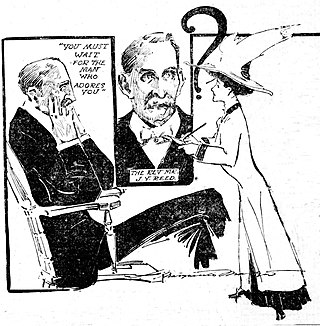
Erving Goffman was a Canadian-born American sociologist, social psychologist, and writer, considered by some "the most influential American sociologist of the twentieth century".
Human communication, or anthroposemiotics, is a field of study dedicated to understanding how humans communicate. Humans' ability to communicate with one another would not be possible without an understanding of what we are referencing or thinking about. Because humans are unable to fully understand one another's perspective, there needs to be a creation of commonality through a shared mindset or viewpoint. The field of communication is very diverse, as there are multiple layers of what communication is and how we use its different features as human beings.

Intrapersonal communication is communication with oneself or self-to-self communication. Examples are thinking to oneself "I'll do better next time" after having made a mistake or imagining a conversation with one's boss in preparation for leaving work early. It is often understood as an exchange of messages in which the sender and the receiver is the same person. Some theorists use a wider definition that goes beyond message-based accounts and focuses on the role of meaning and making sense of things. Intrapersonal communication can happen alone or in social situations. It may be prompted internally or occur as a response to changes in the environment.

Symbolic interactionism is a sociological theory that develops from practical considerations and alludes to humans' particular use of shared language to create common symbols and meanings, for use in both intra- and interpersonal communication. According to Macionis, symbolic interactionism is "a framework for building theory that sees society as the product of everyday interactions of individuals". In other words, it is a frame of reference to better understand how individuals interact with one another to create symbolic worlds, and in return, how these worlds shape individual behaviors. It is a framework that helps understand how society is preserved and created through repeated interactions between individuals. The interpretation process that occurs between interactions helps create and recreate meaning. It is the shared understanding and interpretations of meaning that affect the interaction between individuals. Individuals act on the premise of a shared understanding of meaning within their social context. Thus, interaction and behavior is framed through the shared meaning that objects and concepts have attached to them. From this view, people live in both natural and symbolic environments.

Nonverbal communication (NVC) is the transmission of messages or signals through a nonverbal platform such as eye contact (oculesics), body language (kinesics), social distance (proxemics), touch (haptics), voice (paralanguage), physical environments/appearance, and use of objects. When communicating, we utilize nonverbal channels as means to convey different messages or signals, whereas others can interpret these message. The study of nonverbal communication started in 1872 with the publication of The Expression of the Emotions in Man and Animals by Charles Darwin. Darwin began to study nonverbal communication as he noticed the interactions between animals such as lions, tigers, dogs etc. and realized they also communicated by gestures and expressions. For the first time, nonverbal communication was studied and its relevance questioned. Today, scholars argue that nonverbal communication can convey more meaning than verbal communication.

A social skill is any competence facilitating interaction and communication with others where social rules and relations are created, communicated, and changed in verbal and nonverbal ways. The process of learning these skills is called socialization. Lack of such skills can cause social awkwardness.

Active listening is the practice of preparing to listen, observing what verbal and non-verbal messages are being sent, and then providing appropriate feedback for the sake of showing attentiveness to the message being presented. Active listening is listening on purpose. Active listening is being fully engaged while another person is talking to you. It is listening with the intent to understand the other person fully, rather than listening to respond. Active listening includes asking wide-eyed questions such as, "How did you feel?" or "What did you think?". This form of listening conveys a mutual understanding between speaker and listener. Speakers receive confirmation their point is coming across and listeners absorb more content and understanding by being consciously engaged. The overall goal of active listening is to eliminate any misunderstandings and establish clear communication of thoughts and ideas between the speaker and listener. It may also be referred to as Reflective Listening. By actively listening to another person a sense of belonging and mutual understanding between the two individuals is created. Active listening was introduced by Carl Rogers and Richard Farson, in 1957.
In social science generally and linguistics specifically, the cooperative principle describes how people achieve effective conversational communication in common social situations—that is, how listeners and speakers act cooperatively and mutually accept one another to be understood in a particular way.
Language development in humans is a process which starts early in life. Infants start without knowing a language, yet by 10 months, babies can distinguish speech sounds and engage in babbling. Some research has shown that the earliest learning begins in utero when the fetus starts to recognize the sounds and speech patterns of its mother's voice and differentiate them from other sounds after birth.
Covert hypnosis is an attempt to communicate with another person's unconscious mind without informing the subject that they will be hypnotized. It is also known as conversational hypnosis or sleight of mouth.. It is a term largely used by proponents of neuro-linguistic programming (NLP), a pseudoscientific approach to communication and interaction.
Research into the many possible relationships, intersections and tensions between language and gender is diverse. It crosses disciplinary boundaries, and, as a bare minimum, could be said to encompass work notionally housed within applied linguistics, linguistic anthropology, conversation analysis, cultural studies, feminist media studies, feminist psychology, gender studies, interactional sociolinguistics, linguistics, mediated stylistics, sociolinguistics, and feminist language reform and media studies.
Charles Derber is an American Professor of Sociology at Boston College. His work focuses on the crises of capitalism, globalization, corporate power, neo-fascism, American militarism, the culture of hegemony, the climate crisis, and the new peace and global justice movements.
In the social sciences, coordinated management of meaning (CMM) provides an understanding of how individuals create, coordinate and manage meanings in their process of communication. Generally, CMM is "how individuals establish rules for creating and interpreting the meaning and how those rules are enmeshed in a conversation where meaning is constantly being coordinated", and where "human communication is viewed as a flexible, open and mutable process evolving in an ongoing joint interaction, which enables movement, shifts and evolving ways with each other". CMM embodies this vision and allows interpersonal connection and open conversation among individuals or groups, and can be applicable across multiple academic fields and social scenarios.

Small talk is an informal type of discourse that does not cover any functional topics of conversation or any transactions that need to be addressed. In essence, it is polite and standard conversation about unimportant things.
Civil discourse refers to respectful conversation aimed at fostering understanding and constructive communication, where individuals within a group share different perspectives, enhancing the learning experience. It is a fundamental aspect of freedom of speech, characterized by dialogue that supports the societal good." Members of the U.S. Supreme Court session in 2011 aptly described civil discourse as "robust, honest, frank and constructive dialogue and deliberation that seeks to advance the public interest." Arguments are grounded in reason and evidence, adhering to strict guidelines for the appropriate behavior to be practiced. In contrast, uncivil discourse contains direct insults, unwarranted attributions of motive, and open contempt."
Conversational narcissism is a term used by sociologist Charles Derber in his book, The Pursuit of Attention: Power and Ego in Everyday Life.
Social cues are verbal or non-verbal signals expressed through the face, body, voice, motion and guide conversations as well as other social interactions by influencing our impressions of and responses to others. These percepts are important communicative tools as they convey important social and contextual information and therefore facilitate social understanding.
In linguistics, a backchanneling during a conversation occurs when one participant is speaking and another participant interjects responses to the speaker. A backchannel response can be verbal, non-verbal, or both. Backchannel responses are often phatic expressions, primarily serving a social or meta-conversational purpose, such as signifying the listener's attention, understanding, sympathy, or agreement, rather than conveying significant information. Examples of backchanneling in English include such expressions as "yeah", "OK", "uh-huh", "hmm", "right", and "I see".
Personal narrative (PN) is a prose narrative relating personal experience usually told in first person; its content is nontraditional. "Personal" refers to a story from one's life or experiences. "Nontraditional" refers to literature that does not fit the typical criteria of a narrative.

An interview in qualitative research is a conversation where questions are asked to elicit information. The interviewer is usually a professional or paid researcher, sometimes trained, who poses questions to the interviewee, in an alternating series of usually brief questions and answers. They can be contrasted with focus groups in which an interviewer questions a group of people and observes the resulting conversation between interviewees, or surveys which are more anonymous and limit respondents to a range of predetermined answer choices. In addition, there are special considerations when interviewing children. In phenomenological or ethnographic research, interviews are used to uncover the meanings of central themes in the life world of the subjects from their own point of view.











